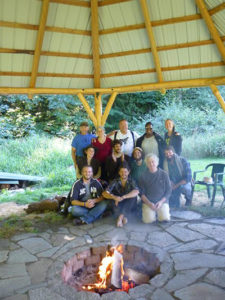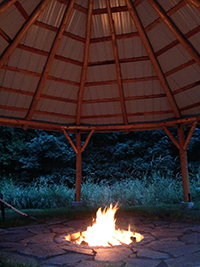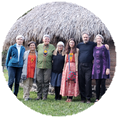Christine Staub, SFC Firekeeper from Greensboro, NC, conducted the interview for us.
 Around the Fire recently caught up with Peter and Sharon Brown, Sacred Fire Firekeepers in Olympia, Washington, U.S.A. Peter was initiated in 2004 (part of the first group of firekeepers). Sharon followed suit in 2005. The Browns moved from Santa Cruz, CA in 2008 after searching for the right place to establish their hearth. They were attracted to the Pacific Northwest by the abundance, a particular culture grounded in working with the land and a strong indigenous presence, along with plenty of water.
Around the Fire recently caught up with Peter and Sharon Brown, Sacred Fire Firekeepers in Olympia, Washington, U.S.A. Peter was initiated in 2004 (part of the first group of firekeepers). Sharon followed suit in 2005. The Browns moved from Santa Cruz, CA in 2008 after searching for the right place to establish their hearth. They were attracted to the Pacific Northwest by the abundance, a particular culture grounded in working with the land and a strong indigenous presence, along with plenty of water.
ATF: Peter and Sharon, would you share something about what led you to step up as SFC firekeepers? It’s no small decision, after all, as it demands a lifetime commitment, ideally to a particular community, a particular place in the world.
Peter: For me the journey began with studying Plant Spirit Medicine with Eliot Cowan in the 90s which led me to being initiated as a Marakame (shaman) in the Wirarika (Huichol) tradition. Fire is central to the Wirarika tradition. The offerings, that we as firekeepers use are given to us by the Huichol people. As part of my apprenticeship there were many days and nights around the fire. I had a personal experience of my heart opening, of transformation, of seeing things coming into my life. I knew I wanted to understand how to work with this energy of fire in community settings, in a traditional manner. Like most firekeepers, I didn’t really know what I was getting into. This work, this commitment is not in the norm of western culture. What it means to be a SFC firekeeper is still evolving for me. What I can say is that Fire has really touched and transformed me, and I continue to grow with fire and work with the teachings.
Sharon: In my case, I was working on a special project in Mexico in 2001 and Fire was central to that. I went on pilgrimage for a few years with the Huichols, and there was a lot of learning from Fire. Pilgrimages are so intently focused and so much deep work is done there. I found myself wanting to bring at least a taste of that to other people. To be honest, one of my challenges as a firekeeper, something I struggle with, is only being able to provide a taste, worrying it may not touch people deeply enough. I admit I need to foster patience sitting with that, allowing this work to unfold in its own time.
ATF: To pick up on Sharon’s use of the word “taste”, we understand that the nature of the place you call home and where your hearth sits actually imparts some of the special “flavor” of each fire keeper’s particular community. Would you both please share something about the Land where you live?
Peter: Olympia is located at the southernmost portion of the Salish Sea (formerly called the Puget Sound). The Pacific Ocean is a short distance to the West and Mt. Rainier to the East, Mt St. Helens to the South and Mt. Baker to the North. It was a couple months after we came to live here before Mt. Rainier, which fills the Eastern skyline, finally appeared from behind perennial clouds. This is when it really clicked for me that this Mountain was a big part of why we had been called here. There is something about the waters here. There is no place I’ve lived that is as abundant as this land, and I’ve lived all over this country. You don’t have to tend anything here. There is so much plant, animal and fish life.
Sharon: I agree with Peter. In the summer, you do have to tend agriculture because it does not rain as much then and yet, it is really abundant here. There are blackberries, mostly Himalayan but also native, everywhere. Blackberry would literally cover everything if we let it! There is also scotch broom, which is a so-called non-native invasive, but it is bringing healing through nitrogen fixing, very helpful when so much rain erodes the soil. There are a lot of grasses, rhododendron, cedar, ferns, ranunculi…
Peter: Blackberries are very distinctive here. Anywhere that sun may fall, blackberries will take over. As a medicine, as an energy, blackberries are about community. The way that they are so intertwined and almost jungle like, brings about a primal aspect of life and living. It is in a similar vein to the bees that live on our land. The bees bring about connection and cross-pollination of life and not just in the western perspective of moving pollen from one plant to the next. It is much more profound and ephemeral. The blackberries are a physical manifestation of this community while the bees are a spiritual manifestation of community.
Sharon: In looking for where to establish our SFC hearth, Peter and I wanted to have enough land to create a community gathering place, more than for just the monthly community fires. We have about 10 acres, and there is a 40-acre buffer of undeveloped, environmentally protected land next door with a creek that runs all the way to the Salish Sea. We are just 2 miles from town, but the land feels like we are out in the countryside.
ATF: Regarding your dream of creating a gathering place for community, we’ve heard that you recently completed a new Fire Structure over your hearth. Can you tell us more about that?
Sharon: There are so many wonderful things to say about this project, because it is about so much more than the finished product. It shows the way that we are, bit by bit, making connections with people in the larger community. This in turn provides a natural opportunity to extend an invitation to join us by the fire.
 The Fire Structure is an open-sided, 26-foot diameter octagon. The proportions feel really good. It makes you feel amazing to sit inside. It was built as an internship project in cooperation with nearby Evergreen State College. While our consultant was Joseph Becker, who is very well known for his natural, mostly cob structures, it was really Tanner Milliern, a recent College graduate, who guided all the work. At 24 years old, this was his first major building project.
The Fire Structure is an open-sided, 26-foot diameter octagon. The proportions feel really good. It makes you feel amazing to sit inside. It was built as an internship project in cooperation with nearby Evergreen State College. While our consultant was Joseph Becker, who is very well known for his natural, mostly cob structures, it was really Tanner Milliern, a recent College graduate, who guided all the work. At 24 years old, this was his first major building project.
Peter: Tanner brought such an incredibly supportive, empowering manner with how he worked with the volunteer crew. He was integral in helping to design it all. It was not part of our original intention to help to empower a young person, but allowing Tanner to step forward and be responsible, mistakes and all, was a wonderful thing to be part of.
About 40-50 Douglas fir trees were chosen from a sustainable forest nearby that required thinning. The interns hand-harvested these after offering gifts of tobacco, brought them down the hill on their shoulders over a weekend in the woods. After the poles arrived on the land, we hand-peeled each one. We had work groups throughout the 3-month construction process, coordinated by Tanner, which focused on staining, notching, erecting and roofing.
ATF: Would you like say more about who is showing up at your fires these days?
Peter: Well, we are newcomers to Olympia, even after 7 years in. People go back generations in this area. We came here with no connections to the community.
 Sharon: No one here had ever heard of the Sacred Fire Community and to show up and say “we have what you need” would be presumptuous. Peter and I each participate in groups and activities in the area, and as we get to know people, we start making invitations. For instance, I go to Tai Chi classes, belong to a drumming group, and occasionally attend a Sacred Sing at the Unity church that is very strong around here.
Sharon: No one here had ever heard of the Sacred Fire Community and to show up and say “we have what you need” would be presumptuous. Peter and I each participate in groups and activities in the area, and as we get to know people, we start making invitations. For instance, I go to Tai Chi classes, belong to a drumming group, and occasionally attend a Sacred Sing at the Unity church that is very strong around here.
Peter: I teach a variety of classes and workshops, give talks at the food coop, a local bookstore/herb/massage store and at the community college. I’m also on the Board of Directors of a low income credit union. There is a wide spectrum of people here. My interest tends to be more in social service/community activism, and Sharon tends more to the arts. I wait longer to invite someone who is a business person than Sharon. Once someone knows I’m a “relatively normal” person, it’s easier to set the context when I make the invitation, namely that what we are offering isn’t exactly a marshmallow roasting, beer-drinking sort of fire, nor a new agey get-in-touch-with-yourself one.
Sharon: We have an average of 8-10 people at most of our fires, mostly middle-aged. We are looking at ways to tap into the vibrant 20 something community that is here because of Evergreen College. Our plan is to offer these young people what we believe is a valuable way of experiencing the world, something that they won’t find in books or on the internet. We’d love to host Ritaka, the SFC’s annual retreat by and for young adults, in the not too distant future. As initiated Graniceros (Weather Workers) in the Nahua tradition of south central Mexico, we hold an annual Harvest Festival on the land as an expression of gratitude.
Peter: We are in the process of remodeling our newly acquired barn into a community space that will support additional events and activities, such as the Sacred Fire Foundation sponsored Voices of Wisdom featuring wisdom keepers and elders from authentic, living traditions. We also hope to host local speakers, drum groups and gatherings of various groups and organizations in the region.
Sharon: There are 22 active tribes in Washington State. This region was not settled by Anglos until the 1850s. So many of the names and places here in Washington are indigenous in nature. There are people alive today, although they are now passing, who can remember stories from their grandparents told of the times when the white people first arrived. There is a revival of tribal cultural practices which inherently align with the Sacred Fire Community’s perspective. There are ways in which we can both support each other and we are exploring these possible relationships as we speak.
ATF: Sharon and Peter, thank you so much for your time. You have painted a rich picture of your work as SFC firekeepers. Readers will want to know that your fires are held on the 1st Saturday of every month.
There are currently 68 FKs holding regular fires in 50 communities across 4 continents. For more information about the Olympia Fire Community or a Community Fire near you, please see here







Loved reading your meet a fire keeper.
You both are doing great work. One day I hope to drop in and smoke a cigar around your fire.
All the best and love Roger. in Alice Springs.